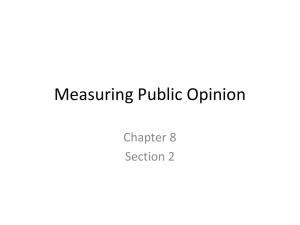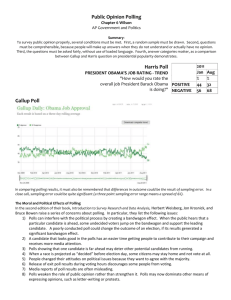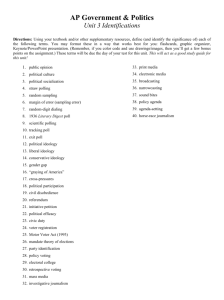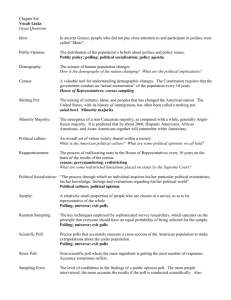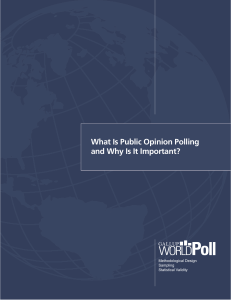United States Government
advertisement
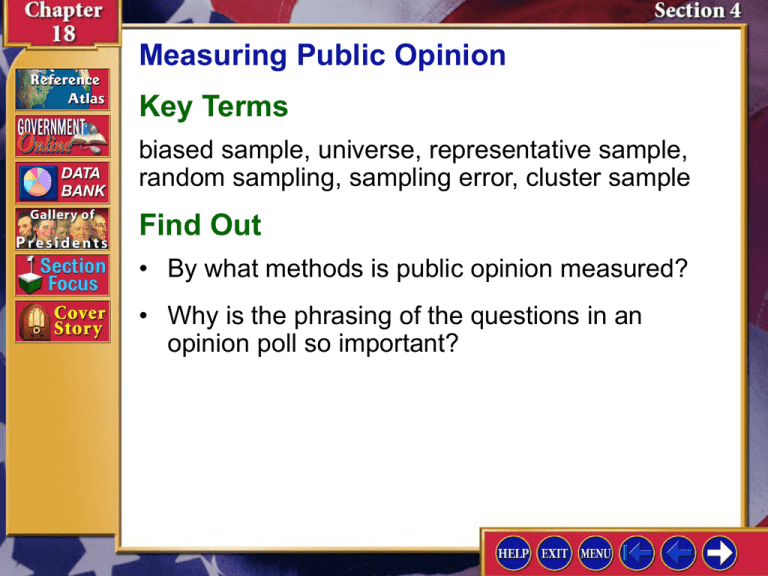
Measuring Public Opinion Key Terms biased sample, universe, representative sample, random sampling, sampling error, cluster sample Find Out • By what methods is public opinion measured? • Why is the phrasing of the questions in an opinion poll so important? Measuring Public Opinion Understanding Concepts Cultural Pluralism In conducting a national poll, why is it important to have a variety of racial, ethnic, and religious groups represented in the sample? Section Objective Evaluate the methods used to measure public opinion. During the presidential election in 1948, public opinion polls heavily favored Thomas E. Dewey over Harry S Truman. The news editors at the Chicago Tribune had been so confident of a Dewey victory that they had printed a “Dewey Defeats Truman” headline and distributed their early edition before the election results were fully tabulated. I. Traditional Methods (pages 519–520) A. Political parties inform party leaders about voters’ attitudes. B. Members of interest groups contact public officials about specific issues, such as gun control, health care, auto safety, and so forth. C. The mass media measure program ratings to gauge public interest. D. Politicians use newspapers, magazine cover stories, editorials, letters to the editor, talk shows, and television newscasts to keep track of public interests. I. Traditional Methods (pages 519–520) E. Relying solely on mass media sources can distort information. F. Letter writing campaigns to public officials by mail, fax, and E-mail indicate levels of support and opposition for specific issues. G. Straw polls organized by media provide responses to specific questions. I. Traditional Methods (pages 519–520) Which of the traditional methods of measuring public opinion do you think is most accurate? Explain. Answers will vary. All traditional methods are somewhat unreliable. II. Scientific Polling (pages 520–522) A. In a scientific poll the term universe refers to the group of people that are to be studied, such as all Texans or all women in the United States. B. A representative sample is a small group of people typical of the universe. C. Most pollsters use representative samples to measure public opinion. D. Using a random sample gives everyone in the universe an equal chance of being selected. II. Scientific Polling (pages 520–522) E. A sampling error defines how much the results may differ from the sample universe. F. A cluster sample is a group of people from the same geographical area. G. Pollsters may weight their results for race, age, gender, or education. H. The way a question is phrased can greatly influence people’s responses. II. Scientific Polling (pages 520–522) I. Polls conducted through telephone interviews and questionnaires sent by mail are cheaper and more convenient than face-to-face interviews. J. Poll results are only a snapshot of public opinion; poll results can be influenced by an interviewer’s appearance or tone of voice and the interviewee’s need to seem knowledgeable or socially acceptable. II. Scientific Polling (pages 520–522) II. Scientific Polling (pages 520–522) Should more or fewer public opinion polls be taken during national elections? Explain. Answers will vary. Students should cite the positive and negative effects of polling. III. Public Opinion and Democracy (page 522) A. The Framers of the Constitution recognized that large numbers of citizens could not run the day-to-day government; they created a government in which people have an active voice by voting for lawmakers. B. The resulting government is responsive to the people but is not subject to the shifting whims of public opinion. III. Public Opinion and Democracy (page 522) What are the benefits and drawbacks of having public opinion shape public policy? Benefit: government more responsive to the people. Drawback: less informed decision making. Checking for Understanding 1. Main Idea Use a graphic organizer like the one below to identify two goals the Framers of the Constitution wanted to meet by creating a representative democracy. representative democracy: provide for popular rule; insulate government from shifting whims of public opinion Checking for Understanding Match the term with the correct definition. ___ F biased sample ___ C universe ___ A representative sample ___ D random sampling ___ E sampling error ___ B cluster sample A. a small group of people, typical of the sample universe, that a pollster questions B. a polling method that groups people by geographical divisions C. in polling, the group of people to be studied D. a polling technique in which everyone in the “universe” has an equal chance of being selected E. a measurement on how much the sample results may differ from the sample universe F. in polling, a group that does not accurately represent the larger population Checking for Understanding 3. Identify straw poll, sample. A straw poll is an unscientific attempt to measure public opinion. A sample is a group surveyed in an opinion poll. Checking for Understanding 4. Identify seven sources that public officials use to determine public opinion. Sources include political parties, interest groups, mass media, letter writing, electronic access, straw polls, and scientific polling. Checking for Understanding 5. List reasons that poll results may not accurately reflect public opinion. Reasons include that the sample may not be representative of the population, questions may be interpreted differently, questionnaires are not returned, pollsters may fail to reach the person being called, interviewer’s appearance or tone of voice can influence answers, individuals sometimes answer the way they think they should, and the respondent may know little about the topic. Critical Thinking 6. Demonstrating Reasoned Judgment Why do politicians pay closer attention to the results of polls conducted through personal interviews rather than through the mail? Mail interviews are not as reliable as personal interviews because only 10 to 15 percent of mail recipients respond, and their replies cannot be clarified. Cultural Pluralism Find a public opinion poll in a newspaper or newsmagazine. Analyze the poll by focusing on the following questions: How many people were contacted? Does the poll include a random or representative sampling? What is the sampling error? Are the questions presented in an unbiased, effective way? Present your answers in an analytical report.
